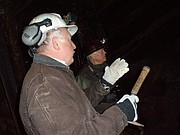Authors delve into obscure past of North Idaho gold rush
Prospectors with gold rush fever once scoured the north side of the Coeur d'Alene Mining District to find their fortunes.
When gold was found on Prichard Creek in 1883, there was a rush that burned hot and fast. Little was left behind to tell the stories of those who braved snows, floods, isolation and worse to maybe, just maybe, strike it rich.
"With the gold rush, poor people can find instant wealth," said author Tony Bamonte. "You can pan. You don’t need machinery. That’s why gold rushes always attract a lot of people. This is it; this is what started everything.”
Tony and his wife, Suzanne, followed the footsteps of those dreamers and schemers, spending more than 15 years researching and collecting information about the gold rush that came before silver entered the North Idaho mining scene.
In late April, the Spokane couple released a comprehensive 500-page book chronicling this untold history. They titled it, "The Coeur d'Alenes Gold Rush and Its Lasting Legacy."
“We’re very proud of the project. There’s this kind of exhaustion, too. I think it’s not quite sunk in, the reality that it’s done and it’s out,” Suzanne said. “We worked so hard to cover anything that was of significance on the north side and try to get it as accurate as we could and bring it up to the present as much as we could.
“We just tried to cover everything. We just sort of took our net and looked at whatever entered."
The Bamontes worked with historians, found photos in private collections, investigated former boom towns, visited defunct mines and heard family stories passed down through generations in their mission to unearth the truth about the north side.
They even dedicated the book to Clarence "Butch" Jacobson, a Mullan resident with a treasure trove of historical materials that aided in their search for information.
“The history has been preserved on the south side, what’s known as the Silver Valley, and Butch had tons of photos, but he didn't have quite as many for the north side," Suzanne said. "What we quickly discovered is that there really were no photos of the gold rush. We had to get creative with maps and illustrations, but he did have photos of the mines and towns."
While they initially embarked on this adventure to write a broader scope of the whole district, they realized the north side had a legacy all its own.
Many interesting stories and facts inundated the Bamontes as they conducted research for the book. The information was already hard to find, but they found themselves having to discern between local tales and what actually happened, which slowed their process.
"We joke about the old adage, ‘Don’t let the facts get in the way of a good story,’ because sometimes we would dig into things and find documentation about something, and it’s like, ‘How did it go from this to this story?’" Suzanne said. "But people get really attached to those stories. It's the folklore, and we didn't want to diminish the folklore, but there were a lot of times it's like, 'That's just not true.'"
Just a few of the interesting topics discussed in the book are: The little town of Bonania, which once existed where Huetter is today; the celebrities who once owned the Golden Chest Mine, which is located southeast of Murray and is the last remaining hard-rock gold mine on the north side; the presence of the powerful Guggenheim family and their dredge on Prichard Creek.
Tony, who was born in Wallace, said this book is a tribute to his father. His dad was a miner and died at a young age because of silicosis, a lung disease caused by breathing tiny particles of silica (a mineral made of sand and rock).
"He was really a good person,” Tony said. “A lot of people in the whole district, you know, there was like over 3,000 people killed in the mines through the ’80s, and that’s not counting the people who died because of the lung problem. It’s a little tribute to him."
The book also serves as a source of information for an otherwise mostly undocumented era for the Coeur d'Alene Mining District. The Bamontes said while much has been written about the gold rushes in California and Alaska, many people don't realize the gold rush that sparked the mining interest in North Idaho led us to where we are today.
“Our area has a lot to be proud of, and a rich history, even though it’s young compared to a lot of areas. We felt like we wanted to capture it," Suzanne said. "We just kind of look at it as our civic duty, I guess, to do something to give back to our community and the area we love."





